Properties
| Storage Buffer | PBS pH7.4, 50% glycerol, 0.09% sodium azide *Storage buffer may change when conjugated |
| Storage Temperature | -20ºC, Conjugated antibodies should be stored according to the product label |
| Shipping Temperature | Blue Ice or 4ºC |
| Purification | Peptide Affinity Purified |
| Clonality | Polyclonal |
| Specificity | Detects ~26kDa. |
| Cite This Product | StressMarq Biosciences Cat# SPC-141, RRID: AB_2177546 |
| Certificate of Analysis | A 1:1000 dilution of SPC-141 was sufficient for detection of Rab4 in 10 µg of heat shocked HeLa cell lysate by colorimetric immunoblot analysis using Goat anti-rabbit IgG:HRP as the secondary antibody. |
Biological Description
| Alternative Names | Oncogene Rab4 Antibody, Rab4A Antibody, Ras related protein Antibody |
| Research Areas | Cell Markers, Cell Signaling, Neuron Markers, Neuroscience, Organelle Markers, Presynaptic Markers, Tags and Cell Markers |
| Cellular Localization | Cytoplasm, Membrane |
| Accession Number | NP_004569.2 |
| Gene ID | 5867 |
| Swiss Prot | P20338 |
| Scientific Background | Rab4 is a 25kDa member of the Rab family of small guanosine triphosphatases (GTPases), Ras superfamily. Rab GTPases are central regulators of membrane trafficking in the eukaryotic cell. Their regulatory capacity depends on their ability to cycle between the GDP -bound inactive and GTP-bound active states. This conversion is regulated by GDP/GTP exchange factors (GEPs), GDP dissociation inhibitors (GDIs) and GTPase-activating proteins (GAPs) (1, 2). Activation of a Rab protein is coupled to its association with intracellular membranes, allowing it to recruit downstream effector proteins to the cytoplasmic surface of a sub-cellular compartment (3). Through these proteins, Rab GTPases regulate vesicle formation, actin- and tubulin-dependent vesicle movement, and membrane fusion(1). Rab proteins contain conserved regions involved in guanine-nucleotide binding, and hyper-variable COHO-terminal domains with a cysteine motif implicated in sub-cellular targeting. Post-translational modification of the cysteine motif with one or two geranylgeranyl groups is essential for the membrane association and correct intracellular localization of Rab proteins (3). Each Rab shows a characteristic sub-cellular distribution (4). In particular, over-expression of Rab4 causes a redistribution of receptors on plasma membrane versus endocytic compartments. The presence of excessive Rab4 leads to the accumulation of tranferrin receptors in non-acidic, post-endosomal recycling vesicles considered an intermediate compartment between endosomes and plasma membranes. Rab4 also plays a role in the translocation of glucose transporter (Glu4) in adipocytes in response to insulin (5). Mediating the association of Rab4 with transferring receptor-containing early endosomes takes place through the geranylgeranyl groups at its carboxyl-terminus. Membrane association is also cell cycle dependent, as phosphorylation at its c-terminal cdc2 kinase consensus sequence in mitotic cells leads to dissociation of Rab4 into the cytosol (6). |
| References |
1. Stenmark H., and Olkkonen V.M. (2001) Genome Biol. 2: 3007.1-3007.7. 2. Takai Y., et al. (2001) Physiol. Rev. 8:, 153-208. 3. Ali B.R., et al. (2004) J. Cell Sci. 117: 6401-6412. 4. Zerial M., and McBride H. (2001) Nat. Rev. Mol. Cell Biol. 2: 107-117. 5. Cormont M., et al. (1996) Mol Cell Biology. 16: 6879-6886. 6. Ayad N., Hull M., and Mellman I. (1997) EMBO 16: 4497-4507. 7. Van der Sluijs, P. et l. (1992) The EMBO Journal 11(12), 4379-4389. |
Product Images

Immunocytochemistry/Immunofluorescence analysis using Rabbit Anti-Rab4 Polyclonal Antibody (SPC-141). Tissue: Heat Shocked Cervical cancer cell line (HeLa). Species: Human. Fixation: 2% Formaldehyde for 20 min at RT. Primary Antibody: Rabbit Anti-Rab4 Polyclonal Antibody (SPC-141) at 1:150 for 12 hours at 4°C. Secondary Antibody: R-PE Goat Anti-Rabbit (yellow) at 1:200 for 2 hours at RT. Counterstain: DAPI (blue) nuclear stain at 1:40000 for 2 hours at RT. Localization: Membrane. Cytoplasm. Magnification: 100x. (A) DAPI (blue) nuclear stain. (B) Anti-Rab4 Antibody. (C) Composite. Heat Shocked at 42°C for 30 min.
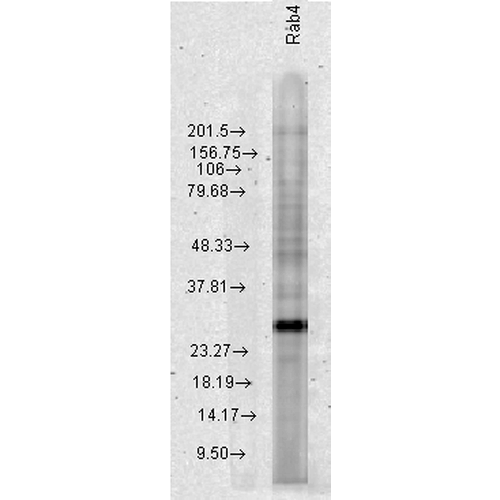
Western blot analysis of Human Cervical cancer cell line (HeLa) lysate showing detection of Rab4 protein using Rabbit Anti-Rab4 Polyclonal Antibody (SPC-141). Load: 15 µgprotein. Block: 1.5% BSA for 30 minutes at RT. Primary Antibody: Rabbit Anti-Rab4 Polyclonal Antibody (SPC-141) at 1:1000 for 2 hours at RT. Secondary Antibody: Donkey Anti-Rabbit IgG: HRP for 1 hour at RT.
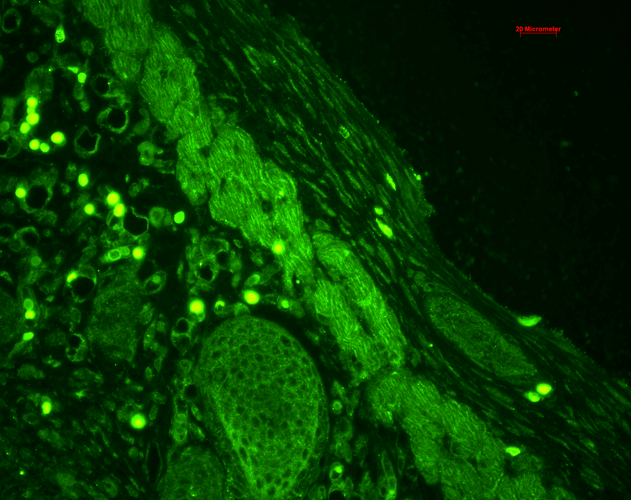
Immunohistochemistry analysis using Rabbit Anti-Rab4 Polyclonal Antibody (SPC-141). Tissue: backskin. Species: Mouse. Fixation: Bouin’s Fixative Solution. Primary Antibody: Rabbit Anti-Rab4 Polyclonal Antibody (SPC-141) at 1:100 for 1 hour at RT. Secondary Antibody: FITC Goat Anti-Rabbit (green) at 1:50 for 1 hour at RT. Localization: Epidermis (cell-cell border and cytoplasmic), hair follicles and muscle.
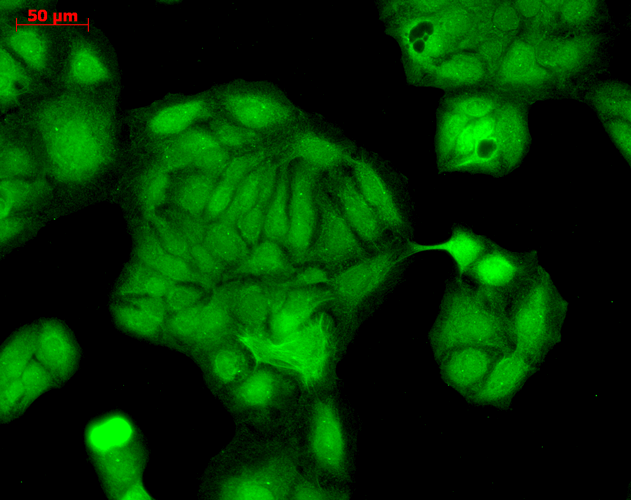
Immunocytochemistry/Immunofluorescence analysis using Rabbit Anti-Rab4 Polyclonal Antibody (SPC-141). Tissue: HaCaT cells. Species: Human. Fixation: Cold 100% methanol at -20C for 10 minutes. Primary Antibody: Rabbit Anti-Rab4 Polyclonal Antibody (SPC-141) at 1:100 for 12 hours at 4°C. Secondary Antibody: FITC Goat Anti-Rabbit at 1:50 for 1-2 hours at RT in dark. Localization: String nuclear and cytoplasmic staining.

Immunocytochemistry/Immunofluorescence analysis using Rabbit Anti-Rab4 Polyclonal Antibody (SPC-141). Tissue: Heat Shocked Cervical cancer cell line (HeLa). Species: Human. Fixation: 2% Formaldehyde for 20 min at RT. Primary Antibody: Rabbit Anti-Rab4 Polyclonal Antibody (SPC-141) at 1:150 for 12 hours at 4°C. Secondary Antibody: APC Goat Anti-Rabbit (red) at 1:200 for 2 hours at RT. Counterstain: DAPI (blue) nuclear stain at 1:40000 for 2 hours at RT. Localization: Membrane. Cytoplasm. Magnification: 20x. (A) DAPI (blue) nuclear stain. (B) Anti-Rab4 Antibody. (C) Composite. Heat Shocked at 42°C for 30 min.

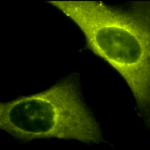
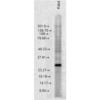
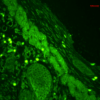
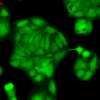
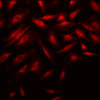




















StressMarq Biosciences :
Based on validation through cited publications.